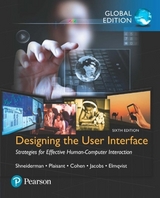
Designing the User Interface: Pearson New International Edition
Pearson Education Limited
978-1-292-02390-8 (ISBN)
- Titel erscheint in neuer Auflage
- Artikel merken
Part I: Introduction
CH 1 Usability of Interactive Systems
1.1 Introduction
1.2 Usability Measures
1.3 Usability Motivations
1.4 Universal Usability
1.5 Goals for Our Profession
CH 2 Guidelines, Principles, and Theories
2.1 Introduction
2.2 Guidelines
2.3 Principles
2.4 Theories
Part II: Development Processes
CH 3 Managing Design Processes
3.1 Introduction
3.2 Organizational Design to Support Usability
3.3 The Four Pillars of Design
3.4 Development Methodologies
3.5 Ethnographic Observation
3.6 Participatory Design
3.7 Scenario Development
3.8 Social Impact Statement for Early Design Review
3.9 Legal Issues
CH 4 Evaluating Interface Designs
4.1 Introduction
4.2 Expert Reviews
4.3 Usability Testing and Laboratories
4.4 Survey Instruments
4.5 Acceptance Tests
4.6 Evaluation During Active Use
4.7 Controlled Psychologically Oriented Experiments
Part III: Interaction Styles
CH 5 Direct Manipulation and Virtual Environments
5.1 Introduction
5.2 Examples of Direct Manipulation
5.3 Discussion of Direct Manipulation
5.4 3D Interfaces
5.5 Teleoperation
5.6 Virtual and Augmented Reality
CH 6 Menu Selection, Form Fillin, and Dialog Boxes
6.1 Introduction
6.2 Task-Related Menu Organization
6.3 Single Menus
6.4 Combinations of Multiple Menus
6.5 Content Organization
6.6 Fast Movement through Menus
6.7 Data Entry with Menus: Form Fillin, Dialog Boxes and Alternatives
6.8 Audio Menus and Menus for Small Displays
CH 7 Command and Natural Languages
7.1 Introduction
7.2 Command-Organization Functionality, Strategies, and Structure
7.3 Naming and Abbreviations
7.4 Natural Language in Computing
CH 8 Interaction Devices
8.1 Introduction
8.2 Keyboards and Keypads
8.3 Pointing Devices
8.4 Speech and Auditory Interfaces
8.5 Displays - Small and Large
CH 9 Collaboration and Social Media Participation
9.1 Introduction
9.2 Goals of Collaboration and Participation
9.3 Asynchronous Distributed Interfaces: Different Place, Different Time
9.4 Synchronous Distributed Interfaces: Different Place, Same Time
9.5 Face-to-Face Interfaces: Same Place, Same Time
Part IV: Design Issues
CH 10 Quality of Service
10.1 Introduction
10.2 Models of Response Time Impacts
10.3 Expectations and Attitudes
10.4 User Productivity
10.5 Variability in Response Time
10.6 Frustrating Experiences
CH 11 Balancing Function and Fashion
11.1 Introduction
11.2 Error Messages
11.3 Nonanthropomorphic Design
11.4 Display Design
11.5 Web Page Design
11.6 Window Design
11.7 Color
CH 12 User Documentation and Online Help
12.1 Introduction
12.2 Online versus Paper Documentation
12.3 Reading from Paper versus from Displays
12.4 Shaping the Content of the Documentation
12.5 Accessing the Documentation
12.6 Online Tutorials and Animated Demonstrations
12.7 Online Communities for User Assistance
12.8 The Development Process
CH 14 Information Visualization
14.1 Introduction
14.2 Data Type by Task Taxonomy
14.3 Challenges for Information Visualization
CH 13 Information Search
13.1 Introduction
13.2 Searching in Textual Documents and Database Querying
13.3 Multimedia Document Searches
13.4 Advanced Filtering and Search Interface
| Verlagsort | Harlow |
|---|---|
| Sprache | englisch |
| Maße | 215 x 274 mm |
| Gewicht | 1072 g |
| Themenwelt | Informatik ► Software Entwicklung ► User Interfaces (HCI) |
| ISBN-10 | 1-292-02390-2 / 1292023902 |
| ISBN-13 | 978-1-292-02390-8 / 9781292023908 |
| Zustand | Neuware |
| Informationen gemäß Produktsicherheitsverordnung (GPSR) | |
| Haben Sie eine Frage zum Produkt? |
